|
gm. Dragacz, pow. świecki, woj. kujawsko-pomorskie

At the times of the Teutonic order the village is mentioned as belonging to Grudziądz komturia. From the second half of the 16th century the settlement belongs to the Nowe poviat in the Pomorskie voivodeship. In 1591 a Dutch named Dreier settled in the village by a separate privilege of Gnieźnieński landlord on 3 włókas and 11 morgas. After signing a tenancy contract for 50 years, in 1592 the Dutch arrived to the village. In 1593 the size of the tenancy amounted to 28 włókas and 4 morgas. 5 craftsmen were known. In 1595 the inhabitants were granted the right to float all kinds of products down the Vistula. In 1611, Dutch Gerd Janson obtained from the landlord Konopacki, Chełm voivode, a privilege to produce alcohol for 60 years. In 1651 the Vistula broke through the dike in four places, silting part of the land, and the king exempted the village from taxes and charges. In 1683 the village sued the parish priest for neglecting the dikes and the priest sued the village for not paying tithes. Both lawsuits were won by the village in 1689. In 1691 king John III renewed the location privilege for the village for 50 years. The village owned 20 włókas, peasants were allowed to brew beer for their own needs. They also paid rent for the Vistula holm. They were completely exempted from harding forced labour. In 1642 in the village there was a hakbuda of Christian Mellerus. In 1740 the Grudziądz starost renewed the emphyteusis contract with the Dutch for 20 włókas.
In the period of the Prussian partition the village was in the Świecie poviat, the Kwidzyn District. It belonged to the Wielki Lubień Catholic parish, the Górna Grupa Evangelic parish. In 1772 the village owned 30 włókas, had 335 inhabitants, 72 horses, 16 foals, 116 cows, 8 heifers, 88 pigs. On the bank of the Vistula the so-called 'Red Inn' was situated. A linear village on the Vistula river, in the eastern part of Nizina Sartowicko-Nowska. The main road runs through the village along the north-south line, along the dike.
In the village eight wooden houses related to Olęder colonisation have survived.

No. 37 - house built c.a. mid-19th century, with its ridge facing a road running along the embankment; situated in the north-eastern part of the village, housing the farm and residential section lined-up under one roof.
The building is on the plan of a rectangle, double-bay with a passage hallway. Kitchen in the eastern bay. The loft has a usable character. Entrance doors in eastern and western elevations. House in form of a rectangle, single-floor, with a cellar under part of it. Covered with a double-pitched roof. Connected with farm section on the northern side. The southern elevation is single-axial, unsymmetrical. The eastern elevation is five-axial, unsymmetrical. The western elevation is tri-axial, unsymmetrical.
The house rests on a brick and stone plinth, is made of wood and has a corner-notched structure. Plastered. The farm section is made of brick. Brick, bottle-shaped chimney. Cement floors. Beam ceilings. The gables are planked. Collar beam roof truss with king posts. Roof covered with metal sheeting. Wooden double-cased windows in window-frames, obtuse. Wooden, double-leaf doors having frame and panel structure. Simple wooden straight-flight staircase.
Documents on which the study was based: Osadnictwo holenderskie Doliny Wisły w województwie bydgoskim, typescript, Bydgoszcz 1992/1993, part 1, p. 6.
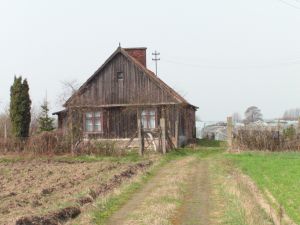 No. 42 - house built on the turn of the third and fourth quarter of the 19th century, with its gable facing a dirt road running parallel to the Dolna Grupa-Grudzi±dz road; located in the south-western part of the village, housing the farm and residential section lined-up under one roof.
No. 42 - house built on the turn of the third and fourth quarter of the 19th century, with its gable facing a dirt road running parallel to the Dolna Grupa-Grudzi±dz road; located in the south-western part of the village, housing the farm and residential section lined-up under one roof.
House in form of a rectangle, single-floor, covered with a double-pitched roof. The northern elevation is five-axial, unsymmetrical. The southern elevation is six-axial, unsymmetrical. The eastern elevation is bi-axial, symmetrical. The western elevation is single-axial, unsymmetrical.
The house is built on a brick and stone plinth, is made of wood and has a corner-notched structure. The gables and walls are planked. The roof is covered with pantiles. Wooden, two-level double-cased windows in window-frames. Wooden, single-leaf doors with a frame and panel structure.

No. 47 - house built in the fourth quarter of the 19th century, with its gable facing a road running along the embankment; located in the western part of the village, residential, not connected with farm buildings. The homestead has a dispersed layout. The building was renovated at the end of the nineties of the 20th century and completely lost its original character.
The house is built on the plan of a rectangle, double-bay with a hallway and a kitchen in the southern bay. The loft has a residential and usable character. Entrance door in the southern elevation. House in form of a rectangle, with a cellar under part of it, single-floor. Covered with a double-pitched roof. Window orifice in the roof surface. The northern elevation is bi-axial, symmetrical. The southern elevation is tri-axial, symmetrical. The eastern elevation is bi-axial, symmetrical. The western elevation is single-axial, symmetrical.
The house is built on a brick and stone plinth, is made of wood and has a corner-notched structure, contemporarily planked. Brick, simple chimney. Cement floors. Collar beam roof truss. Roof covered with metal sheeting. Plastic, one-frame widnows. Wooden single-leaf doors. Simple wooden straight-flight staircase.
Documents on which the study was based: Osadnictwo holenderskie Doliny Wisły w województwie bydgoskim, typescript, Bydgoszcz 1992/1993, part 1, p. 6; Katalog zabytków województwa bydgoskiego, elaborated by K. Parucka, E. Raczyńska-M±kowska, Bydgoszcz 1997, p. 55; Zabytki architektury i budownictwa w Polsce. Województwo Bydgoskie, elaborated by E. Parucka, vol. 5, Warszawa 1997, p. 83; M. Obremski, Wykaz zabytków nieruchomych z terenu gmin: Dragacz, Drzycim, Nowe, Osie ¦wiecie i Warlubie, [in:] Materiały V Sympozjum Wi¶lanego Zabytki Kociewia, eds. R. Klim, Tczew 1999, p. 173.
 No. 53 - house built in the third quarter of the 19th century, with its gable facing a road running along the embankment; situated in the north-western part of the village, housing the farm and residential section lined-up under one roof.
No. 53 - house built in the third quarter of the 19th century, with its gable facing a road running along the embankment; situated in the north-western part of the village, housing the farm and residential section lined-up under one roof.
Built on the plan of a rectangle, double-bay with a hallway in the southern bay. Kitchen in the northern bay. Entrance door in the southern elevation. The loft has a usable character. House has a form of a rectangle and is single-floor. Covered with a double-pitched roof. The northern and southern elevations are tri-axial, unsymmetrical. To the southern elevation adjoins a porch with a double-pitched roof. The eastern elevation is bi-axial, unsymmetrical. The western elevation is single-axial, unsymmetrical.
The house is built on a brick and stone plinth, is made of wood and has a corner-notched structure. Plastered. Brick, bottle-shaped chimney. The floor in the kitchen is made of cement and in other rooms it is made of battens. Beam ceiling. The gables are planked. Collar beam roof truss. The roof is covered with pantiles. Brick porch. Wooden double-cased windows in window-frames. Wooden, single-leaf doors having frame and panel structure. Simple wooden straight-flight staircase.
Documents on which the study was based: Osadnictwo holenderskie Doliny Wisły w województwie bydgoskim, typescript, Bydgoszcz 1992/1993, part 1, p. 6.
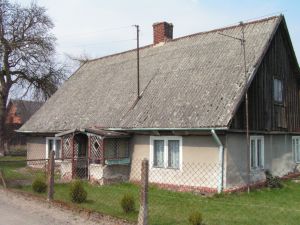 No. 56 - house built in the third quarter of the 19th century (?), with its ridge facing the road running perpendicularly to the embankment; located in the north-western part of the village, not connected with farm buildings. The homestead has a dispersed layout.
No. 56 - house built in the third quarter of the 19th century (?), with its ridge facing the road running perpendicularly to the embankment; located in the north-western part of the village, not connected with farm buildings. The homestead has a dispersed layout.
Single-floor, covered with a double-pitched roof. The northern elevation unavailable. The southern elevation is tri-axial, symmetrical, with a porch having a double-pitched roof. The eastern and western elevations are bi-axial, symmetrical.
The house is built on a brick and stone plinth, is made of wood and has a corner-notched structure. Plastered. The gables are planked. The roof is covered with asbestos cement. The porch is made of brick. Wooden double-cased windows in window-frames. Wooden single-leaf doors with a frame and panel structure.
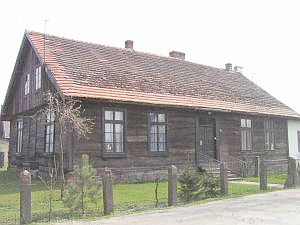 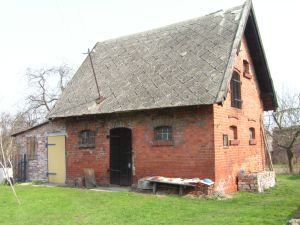
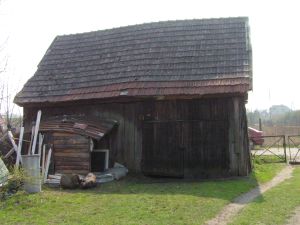
No. 58 - house built in the third quarter of the 19th century, with its gable facing a road running perpendicularly to the embankment; situated in the north-western part of the village, not connected with farm buildings. The homestead has a dispersed layout. From the twenties to the sixties of the 20th century the building was used as a school.
The building is on the plan of a rectangle, double-bay with a passage hallway. The loft has a usable character. Entrance doors in the eastern and western elevations. Single-floor, with a cellar under part of it. Covered with a double-pitched roof. The northern elevation is bi-axial, symmetrical. An annex adjoins the southern elevation. The eastern elevation is five-axial, unsymmetrical. The southern elevation is five-axial, symmetrical.
The house rests on a brick and stone plinth, is made of wood and has a corner-notched structure. Brick, simple chimney. Batten floors, ceilings made of ceiling joists with bevelled edges. The gables are planked. Collar beam roof truss with king posts. Roof covered with double lapped fish-scale tiles. Brick, plastered annex. Wooden, double-cased, two-level windows in window-frames. Wooden, single- and double-leaf doors with frame and panel structure. Simple wooden straight-flight staircase.
Documents on which the study was based: Osadnictwo holenderskie Doliny Wisły w województwie bydgoskim, typescript, Bydgoszcz 1992/1993, part 1, p. 173; Zabytki architektury i budownictwa w Polsce. Województwo Bydgoskie, elaborated by E. Parucka, vol. 5, Warszawa 1997, p. 83; Katalog zabytków województwa bydgoskiego, elaborated by K. Parucka, E. Raczyńska-M±kowska, Bydgoszcz 1997, p. 55; M. Obremski, Wykaz zabytków nieruchomych z terenu gmin: Dragacz, Drzycim, Nowe, Osie ¦wiecie i Warlubie, [in:] Materiały V Sympozjum Wi¶lanego Zabytki Kociewia, eds. R. Klim, Tczew 1999, p. 173; Dragacz 58, Historic Monuments of Architecture and Construction Registry Card, elaborated by A. Klugowska, typescript, Bydgoszcz 2003.
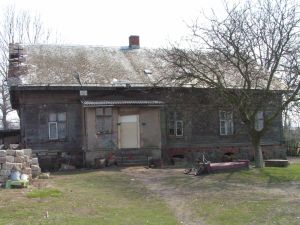 
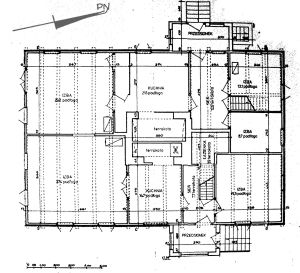
No. 117 - house built on the turn of the 3rd and 4th quarter of the 19th century, with its ridge facing a road running along the embankment; located in the north-western part of the village, not connected with farm buildings. The homestead has a dispersed layout.
House built on the plan of a rectangle, double-bay with a passage hallway. Kitchens in the middle axis, with preserved \'black kitchen\'. At present the building is divided into two independent apartments. The loft has a residential and usable character. Entrance doors in the eastern, western and southern elevations. Single-floor with a pointing sill, has a cellar under the entire first floor and is covered with a double-pitched roof. The northern elevation is tri-axial, symmetrical. The southern elevation is four-axial, symmetrical. The eastern and western elevations are five-axial, symmetrical, with porches having double-pitched roof.
The house is built on a brick and stone plinth, is made of wood and has a corner-notched structure. Brick, bottle-shaped chimney. Wooden floors, tiles in the kitchen. Ceilings made of ceiling joists with bevelled edges. The gables are planked. Pointing sill having corner-notched structure. Collar beam roof truss with king posts. Roof covered with ceramic tiles. Wooden double-cased, two-level windows in window-frames. Wooden, single-leaf doors having frame and panel structure and contemporary board doors. Simple wooden straight-flight staircase.
Documents on which the study was based: Historic Monuments of Architecture and Construction Registry Card, Dragacz 117, elaborated by I. Jastrzębska-Puzowska, E. Sekuła-Tauer, K. Bartkowski, typescript, Bydgoszcz 1993; Osadnictwo holenderskie Doliny Wisły w województwie bydgoskim, typescript, Bydgoszcz 1992/1993, part 1, p. 6; Osadnictwo holenderskie Doliny Wisły w województwie bydgoskim, typescript, Bydgoszcz 1992/1993, part 3, No..19; Katalog zabytków województwa bydgoskiego, elaborated by K. Parucka, E. Raczyńska - M±kowska, Bydgoszcz 1997, p. 55; Zabytki architektury i budownictwa w Polsce. Województwo Bydgoskie, vol. 5, Warszawa 1997, p. 83; Obremski M., Wykaz zabytków nieruchomych z terenu gmin: Dragacz, Drzycim, Nowe, Osie ¦wiecie i Warlubie, [in:] Zabytki Kociewia, eds. R. Klim, Tczew 1999, p. 173.
Słownik geograficzny Królestwa Polskiego i innych krajów słowiańskich, red. B. Chlebowskiego, t. 12, Warszawa 1892, s. 442; H. Maercker, Eine polnische Starostei und ein preussischer Landrathkreis. Geschichte des Schwetzer Kreises 1466-1873, "Zeitschrift des Westpreussischen Geschichtvereins", H. 17-19, Danzig 1886-1888, s. 183-4; Słownik geograficzny Państwa Polskiego i ziem historycznie z Polską związanych,, red. S. Arnold, 1937, s. 1225-6; Opis królewszczyzn w województwach chełmińskim, pomorskim i malborskim w roku 1664, wyd. J. Paczkowski, TNT, Fontes 32, Toruń 1938, s. 81; Inwentarz starostwa grudziądzkiego z roku 1739, Grudziądz 1963, s. 51; Inwentarz starostwa grudziądzkiego z roku 1603 oraz rejestr dochodów z lat 1601-1603, wyd. S. Cackowski, Grudziądz 1965, s. 27-28;Lustracja województw Prus Królewskich 1624 z fragmentami lustracji 1615, wyd. S. Hoszkowski, Gdańsk 1967, s. 46, 265; K. Ciesielska,, Osadnictwo "olęderskie" w Prusach Królewskich na Kujawach w świetle kontraktów osadniczych, "Studia i Materiały z dziejów Wielkopolski i Pomorza", t. 4, 1958, s. 223; Katalog zabytków architektury i budownictwa w Polsce, z. 2, M. Arszyński, M. Rejmanowski, Województwo bydgoskie,(Biblioteka Muzealnictwa i Ochrony Zabytków, Seria A, t. VII, Warszawa 1972, s. 58; Zabytki architektury województwa bydgoskiego, red. M. E. Gąsiorowscy, Bydgoszcz 1974, s. 223; Katalog zabytków sztuki w Polsce, T.XI, Dawne województwo bydgoskie, red. T. Chrzanowski, M. Kornecki, z. 15: Powiat świecki, oprac. T. Chrzanowski i T. Żurkowska, Warszawa 1977, s. 3; Katalog zabytków województwa bydgoskiego, oprac. K. Parucka, E. Raczyńska-Mąkowska, Bydgoszcz 1997, s. 55; P. J. Klassen, Ojczyzna dla przybyszów, Wprowadzenie do historii mennonitów w Polsce i Prusach, Warszawa 2002, s. 42.Słownik geograficzny Królestwa Polskiego i innych krajów słowiańskich, red. B. Chlebowskiego, t. 12, Warszawa 1892, s. 442; H. Maercker, Eine polnische Starostei und ein preussischer Landrathkreis. Geschichte des Schwetzer Kreises 1466-1873, "Zeitschrift des Westpreussischen Geschichtvereins", H. 17-19, Danzig 1886-1888, s. 183-4; Słownik geograficzny Państwa Polskiego i ziem historycznie z Polską związanych,, red. S. Arnold, 1937, s. 1225-6; Opis królewszczyzn w województwach chełmińskim, pomorskim i malborskim w roku 1664, wyd. J. Paczkowski, TNT, Fontes 32, Toruń 1938, s. 81; Inwentarz starostwa grudziądzkiego z roku 1739, Grudziądz 1963, s. 51; Inwentarz starostwa grudziądzkiego z roku 1603 oraz rejestr dochodów z lat 1601-1603, wyd. S. Cackowski, Grudziądz 1965, s. 27-28;Lustracja województw Prus Królewskich 1624 z fragmentami lustracji 1615, wyd. S. Hoszkowski, Gdańsk 1967, s. 46, 265; K. Ciesielska,, Osadnictwo "olęderskie" w Prusach Królewskich na Kujawach w świetle kontraktów osadniczych, "Studia i Materiały z dziejów Wielkopolski i Pomorza", t. 4, 1958, s. 223; Katalog zabytków architektury i budownictwa w Polsce, z. 2, M. Arszyński, M. Rejmanowski, Województwo bydgoskie,(Biblioteka Muzealnictwa i Ochrony Zabytków, Seria A, t. VII, Warszawa 1972, s. 58; Zabytki architektury województwa bydgoskiego, red. M. E. Gąsiorowscy, Bydgoszcz 1974, s. 223; Katalog zabytków sztuki w Polsce, T.XI, Dawne województwo bydgoskie, red. T. Chrzanowski, M. Kornecki, z. 15: Powiat świecki, oprac. T. Chrzanowski i T. Żurkowska, Warszawa 1977, s. 3; Katalog zabytków województwa bydgoskiego, oprac. K. Parucka, E. Raczyńska-Mąkowska, Bydgoszcz 1997, s. 55; P. J. Klassen, Ojczyzna dla przybyszów, Wprowadzenie do historii mennonitów w Polsce i Prusach, Warszawa 2002, s. 42.
|


 No. 42 - house built on the turn of the third and fourth quarter of the 19th century, with its gable facing a dirt road running parallel to the Dolna Grupa-Grudzi±dz road; located in the south-western part of the village, housing the farm and residential section lined-up under one roof.
No. 42 - house built on the turn of the third and fourth quarter of the 19th century, with its gable facing a dirt road running parallel to the Dolna Grupa-Grudzi±dz road; located in the south-western part of the village, housing the farm and residential section lined-up under one roof.
 No. 53 - house built in the third quarter of the 19th century, with its gable facing a road running along the embankment; situated in the north-western part of the village, housing the farm and residential section lined-up under one roof.
No. 53 - house built in the third quarter of the 19th century, with its gable facing a road running along the embankment; situated in the north-western part of the village, housing the farm and residential section lined-up under one roof. No. 56 - house built in the third quarter of the 19th century (?), with its ridge facing the road running perpendicularly to the embankment; located in the north-western part of the village, not connected with farm buildings. The homestead has a dispersed layout.
No. 56 - house built in the third quarter of the 19th century (?), with its ridge facing the road running perpendicularly to the embankment; located in the north-western part of the village, not connected with farm buildings. The homestead has a dispersed layout.




